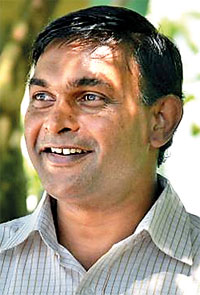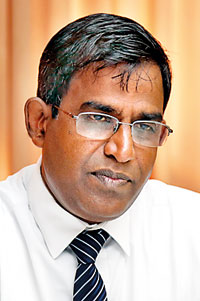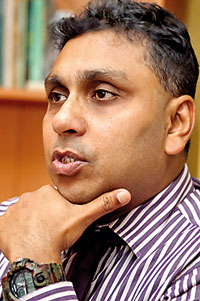Bridging a special need through drama
View(s):
Dr. Ravindra Ranasinha
The show is over but the impact of getting on stage and following their dreams will linger for a long time…….and now the hope is to carry the message forward to encompass the whole country.
The message is all about drama therapy and its impact on both children and adults with special educational needs.
“We used drama therapy as an educational tool,” says Director Lt. Col. Prasanna Hettiarachchi of the Senehasa Education, Resource, Research and Information Centre (SERRIC) run by the Defence Ministry for around 320 children and young people in the age-group 2½ to 24 years. SERRIC located at Narahenpita with state-of-the-art facilities, caters to children with special needs of personnel in the tri forces and police as well as 15% of civilians.
Lt. Col. Hettiarachchi says that everyone calls them special children without focusing on their needs, explaining that different children have different needs.
The ideas for the very successful show that they took to the stage on October 2, Children’s Day at the Bishop’s College auditorium, which got a standing ovation were garnered from the children themselves.
For Dr. Ravindra Ranasinha, Head of the Research Centre for Drama Therapy in Colombo 8, who is the only person in Sri Lanka to hold a doctorate in drama therapy, the links with SERRIC were forged when Consultant Psychiatrist Dr. Ravimal Galappaththi put him in touch with them and he offered a voluntary service.
He first entered SERRIC in March to train the trainers – to strengthen the skills of the 18 teachers to support the development of these children with special educational needs through drama therapy.

Lt. Col. Prasanna Hettiarachchi
Into use he took the four basic drama therapy tools – story-telling, role-playing, movement and pantomime. Citing an example, Dr. Ranasinha says that a voice can be used in a story to let a child understand sound and echo it.
“Echoing is a special aspect in special education,” he says, pointing out that mirroring is also about getting the child to act the way you are acting through sound and performance.
According to him there is a neurological background to this – experiments with monkeys in France in the 1990s had shown that they had mirror neurons in the brain, as do humans. These mirror neurons help us to understand and imitate others. This aspect is important when it comes to special education, as some children who are non-verbal may not utter sounds but mirror actions. The need is to find out how they can communicate and socially interact with others, by finding action methods even imagination to enhance their verbal and non-verbal skills.
By September, SERRIC saw the potential of having a performance and needed guidance. The suggestion was that the children should act in a drama.
“My approach was different,” says Dr. Ranasinha. His recommendation was ethno-drama therapy which had been researched in Canada. This was the model that he wanted to bring to Sri Lanka.
It began as a research, after all protocols and consents had been taken. The teachers sat with Dr. Ranasinha and discussed what they knew about the children – were they verbal or non-verbal. Next they had two weeks to talk to the children, observe them and ask them and then identify what specific talents the children had and also what their wishes, hopes, thoughts, dreams and emotions were which made them “total” persons.
All this was brought in the form of raw data to Dr. Ranasinha who then analysed them.
“We got four major themes,” he says. They were:
- Love
- Hope
- Cooperation
- Happiness
Using not only the teachers but also the parents who were the “best informers” about their children, they were grouped under the different themes.
“The teachers had never had this experience and even for the administrators it was a novel experience,” he says, stressing there were doubts, “yes strong doubts” until the very last, but it paid off.
“I like to be a bride,” was a ‘hope’ expressed by one child and they did make her a bride on stage, even though she was unable to verbalize it. A lot of work went into this simple action – the child going to a shop, selecting a dress, being dressed as a bride and then finally going on stage and getting her picture as a bride on a video wall.

Dr. Ravimal Galappaththi
Under ‘cooperation’ was spotlighted twin autistic brothers helping each other – one assisting his brother to put on his shoes, then holding each other’s hands and tapping the palms, to show that they are part of a community.
Music and dance were very much a part of the programme and when one non-verbal child indicated that he would like to play the drums, a perahera was created, becoming part of the performance and also the community. This was while among the performers were also 30 children from Grades 8 and 9 from a school nearby who at first found it difficult to mingle with the SERRIC children but transformed within a few days proving that “inclusivity” was an advantage for both groups.
Another child with no hands and legs came onto the stage and drew a picture on the video wall using a pastel wedged between her lips, smilingly telling the audience: “I can do things that you can’t do”, evoking a major response from the audience.
“Everything was improvised based on what the children wanted to do,” says Dr. Ranasinha, adding that slowly the performance structure took form.
The rehearsals were very moving to watch, MediScene understands, with the interaction obvious. Some smiled, some hugged and others just held hands and did not let go, though there was no smile. There was a ‘dynamic space’ where talking was carried out sometimes without words but through smiles and expressions.
Social interaction was very good but now we need to check how the children felt. We need to find out how their lives have improved after this and a mechanism to do so should come from within the institution itself, says Dr. Ranasinghe, stressing that the children may not be able to do mathematics or English, but through the latent skills and talents they have “we can restore their dignity”.

| Going public with their creativity Drama therapy allowed these children and young adults to give expression to whatever they could do and this is medically beneficial, said Consultant Psychiatrist Dr. Ravimal Galappaththi, pointing out that it seemed to help harness those faculties that may have been affected by the brain damage suffered by these children which has led to social inhibitions. These children have a right to express themselves at whatever level they can and this is what drama therapy paved the way for them to do, making use of their creativity. Drama therapy also helped to identify the strengths of each and every child, while engaging and involving the family as well to bring about better communication, he pointed out. By going public, we hoped to bring about a change in attitude towards these children, reducing negativity and stigma, added Dr. Galappaththi. | |


